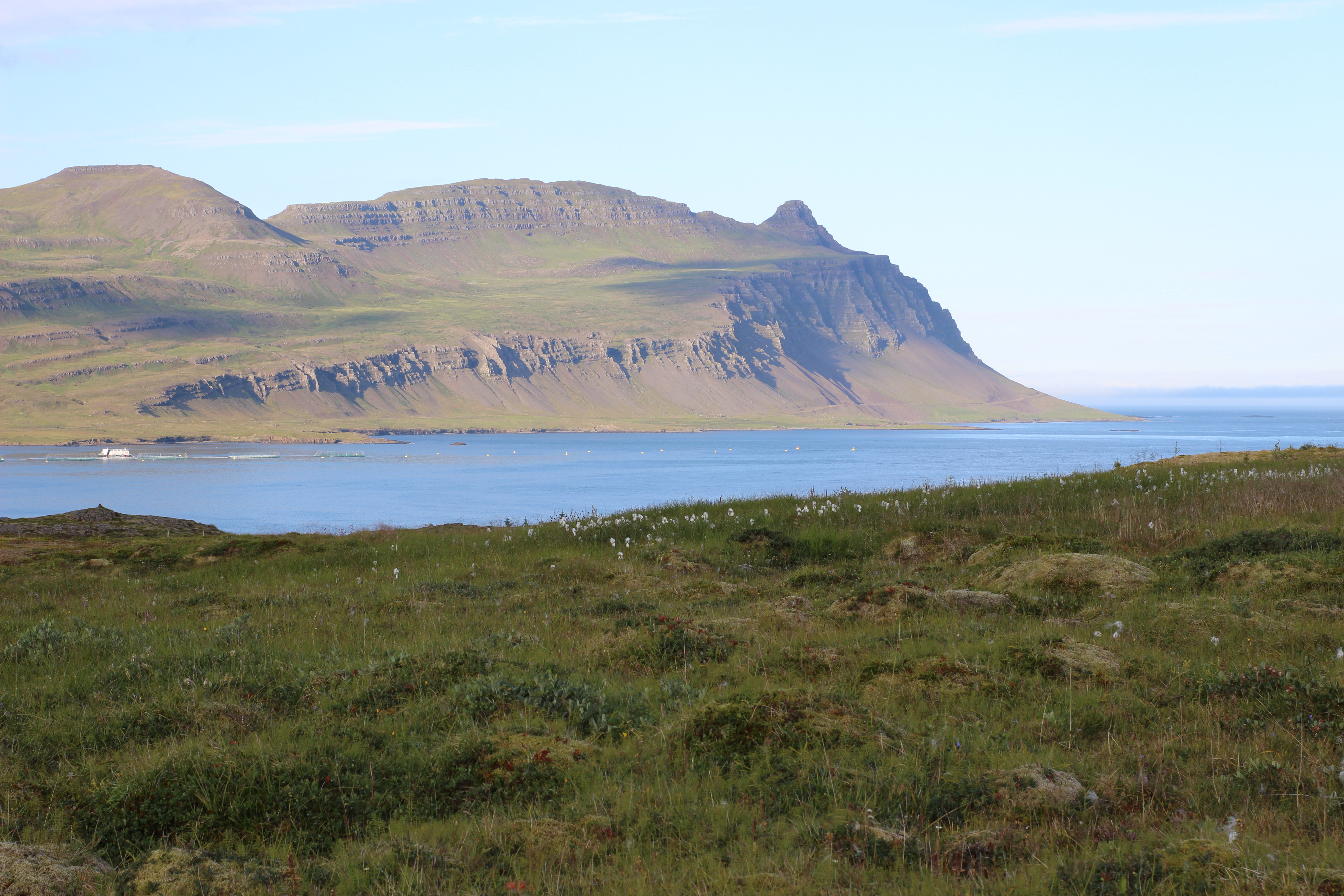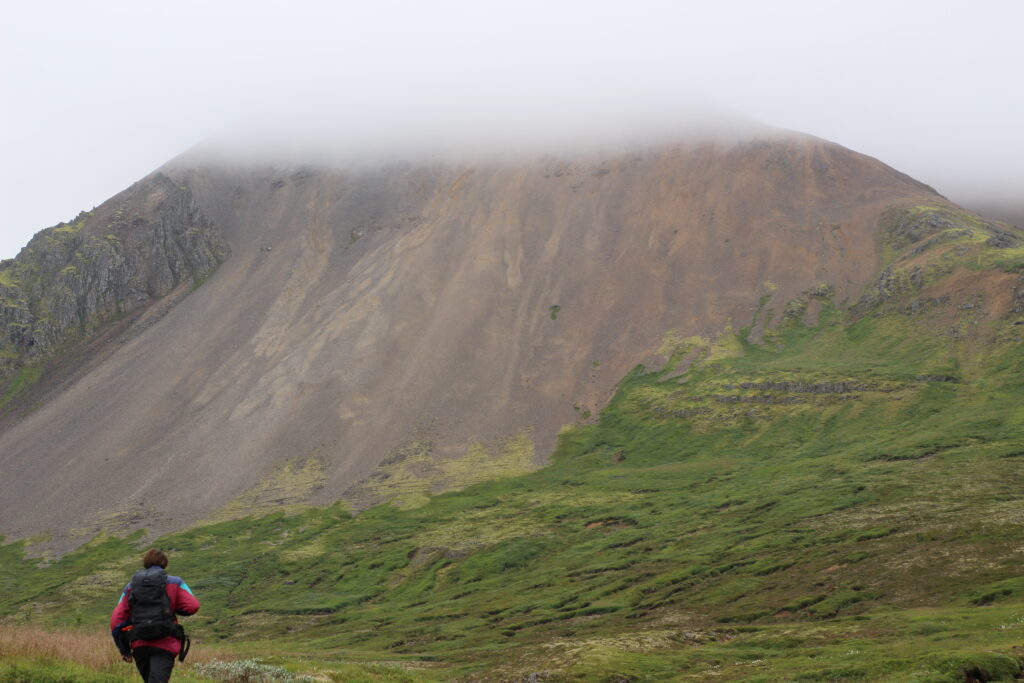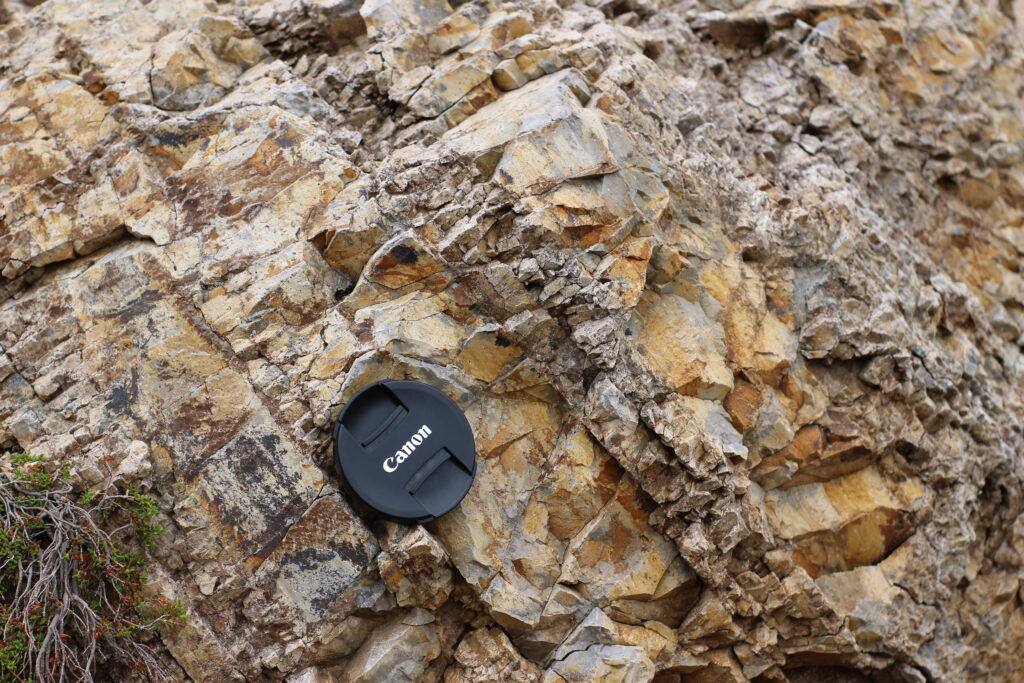
To go out into the field and safely explore volcanic systems is an integral part of understanding volcanic processes, that can bring discovery, inspiration, and joy to those who research them. Restrictions due to covid have meant that volcano researchers have been unable to do fieldwork as often as they might like, leaving them yearning to get back out there and inspect igneous rocks! Earlier this year, a team of researchers from Uppsala University and the University of Liverpool were therefore ecstatic to go on a long-awaited fieldtrip to one of the most exciting parts of the world for VIPS enthusiasts – Eastern Iceland.
The landscape of Eastern Iceland is dominated by mountainous terrain dissected by deep fjords. Glacial erosion has exposed a lava pile with a thickness of 10-12 kilometres, that originated from the previous terrestrial location of the active rift zone of the Mid-Atlantic ridge to the west. This lava pile forms part of the oldest stratigraphic unit in Iceland, the Tertiary crust, where all rocks are older than 3.3 million years. Embedded within the Tertiary layers are an abundance of ancient, fossilised sub-volcanic structures. East Iceland therefore offers a unique and fascinating insight into the volcanic plumbing systems at currently active rift zones, providing the perfect natural laboratory for understanding magma transport and storage… not to mention a very exciting location for a VIPS expedition.

Meet the Team
The fieldwork expedition was led by expert on East Iceland volcanology, and VIPS co-founder, Dr Steffi Burchardt, who has been captivated by the volcanic systems of Iceland since her Master’s studies on the Geitafell Volcano in the Southeast. Steffi is now an associate professor at Uppsala University, Sweden, where she leads a team of PhD researchers who study different aspects of magma transport and storage processes. The Uppsala team were joined on the trip by a group of researchers from the University of Liverpool, UK, led by VIPS co-founder and current President Dr Janine Kavanagh. Janine and her team work on analogue and numerical models of dykes to compare with field studies (they were in for a treat – dykes are a regular feature of the Eastern Icelandic landscape). In total the field expedition was composed of eight researchers, with diverse research backgrounds and levels of field experience, yet with a shared passion for the wonderful (and sometimes wacky) world of volcanic plumbing systems.

The research team on the grand VIPS tour of East Iceland.
The Expedition

The grand VIPS tour extended from north to south of Eastern Iceland, corresponding to deeper and deeper erosion levels… and more and more exposures! This is the home of several extinct central volcanoes, that were once dominated by basaltic magmatic activity, interspersed with several phases of rhyolitic activity (Burchardt et al., submitted). The setting provides the ideal field-laboratory for investigating complex processes of magma transport and storage, such as the flow behaviour of very viscous, rhyolitic magma, and the interaction of mafic and felsic magmas when they come into contact with each other. Associated with the central volcanoes are swarms of dykes cutting through the bedrock, that were once responsible for transporting magma up towards the surface.
In the north, the Borgarfjordur eystri area is home to four extinct central volcanoes that, until recently, were relatively unexplored. Steffi and colleagues recently submitted the first comprehensive geological map of the area to Volcanica. In between periods of intense Icelandic fog, Steffi brought the group to see the best exposures of the central volcanoes, which all underwent caldera-forming ignimbrite eruptions. The whole group spent one unusually sunny day hiking around the Dyrfjöll caldera beneath exposed layers of olivine basalt on top of hyaloclastite and ignimbrite. The hyaloclastite formed during basaltic eruptions that interacted with water in the caldera lake around 12.4 million years ago. Up close, the hyaloclastite looks like an assorted mix of fragmented rock forced together, although it’s actually homogeneous on a large scale. The Dyrfjöll caldera is scattered with huge blocks of hyaloclastite, that according to folklore, provide homes for the elves that live there.
Further south along Eastern Iceland is the Reydarfjördur central volcano, containing well-preserved rhyolitic intrusions. One of the most striking exposures in this area is the Sandfell laccolith – a distinct, dome-shaped, rhyolitic intrusion in the basaltic flank of the volcano. Sandfell was the site of five days of intense fieldwork for Taylor Witcher, who is researching how viscous magma behaves in shallow chambers for her PhD project. Taylor was seeking fracture bands in the Sandfell laccolith, which can provide evidence for the brittle breakage of viscous, rhyolitic magma when put under a lot of stress. Taylor found fracture bands all over the laccolith and mapped their orientation, spacing, and shapes. She will use 3D reconstructions and restoration to analyse the conditions in which the fracture bands formed. Another intrusion at Sandfell – a rhyolitic sill – was mapped in detail by Sonja Greiner using a drone, to aid the development of numerical models of host rock deformation around magma intrusions.
At the coast, Reydarfjördur is abundant with swarms of dyke exposures of all different sizes, with many unexpected features. One of the most impressive exposures is the Streitishvarf composite dyke, which cuts across several fjords with a length of at least 15 kilometres. The most striking characteristic is the presence of dark, mafic margins that transition into a pale, felsic core. Analysis of magnetic fabrics suggests that the layered dyke formed when a propagating mafic dyke intruded a stationary felsic body over 10 million years ago, and the heat from the mafic body mobilised the felsic magma (see Eriksson et al., 2011). The distinct layers are remarkably evident in the Streitishvarf exposure, which led to a new nickname for the exposure on the fieldtrip – the Oreo Dyke. The fascinating fluid dynamics processes of magma mixing are well-preserved in the rock textures at the mafic-felsic transition interface. Liverpool PhD student Tegan Havard collected samples of the Streitishvarf/Oreo dyke for her research on magma mixing in dykes, which she is also using analogue experiments to investigate.

In the south east of Iceland, the deeper erosion levels reveal exposures of the large magma chambers at central volcanoes, plutons. For the past four years, the felsic Reydaratindur pluton has been the focus of the PhD project of Emma Rhodes at Uppsala, who gave the rest of the group a tour of her fieldwork location
The pluton is over 7 million years old, with a volume greater than 2.5 cubic kilometres. It is characterised by the mixing and mingling of three different types of felsic magmas, which can be seen in exposures of the pluton base. Using techniques including field mapping, geochemistry, and thermal modelling, Emma’s research suggests that the pluton was emplaced rapidly and fed eruptions through conduits exposed at the pluton roof. Check out the recently published paper written by Emma and colleagues to find out more!

The younger, neighbouring pluton Slaufrudalur, is now being explored by Orlando Quintela, whose research aims to understand how fluids and elements are transported within solidified chambers, for geothermal energy applications
After thirteen days of travelling the east coast of Iceland together, the expedition came to an end. Despite the group having different backgrounds and research interests, Eastern Iceland provided something for all – whether it was 40 kilograms of rock samples from the field, or a first glimpse into the physical world that modellers try to recreate. The unique geological setting of Iceland brings endless potential for researchers of volcanoes to explore and discover. Watch this space for more details on the individual projects that greatly benefitted from the grand VIPS tour of East Iceland.
Further reading
- Burchardt, S., Óskarsson, B. V., Gustafsson, L. E., Berg, S. E., Riishuus, M.S., (submitted). Geology of a Neogene caldera cluster in Northeast Iceland – clues into rift zone architecture on a young Iceland
- Eriksson, P. I., Riishuus, M. S., Sigmundsson, F., Elming, S.-Å. (2011). Magma flow directions inferred from field evidence and magnetic fabric studies of the Streitishvarf composite dike in east Iceland
- Rhodes, E. L., Barker, A. K., Burchardt, S., Hieronymus, C. F., Rousku, S. N., McGarvie, D. W., Mattsson, T., Schmiedel, T., Ronchin, E., Witcher, T. (2021). Rapid assembly and eruption of a shallow silicic magma reservoir, Reyðarártindur Pluton, Southeast Iceland
Have you been on any fieldwork recently?
We would love to hear your stories from the field. If you have an experience to share, whether you’re a student, an early career researcher, or more experienced researcher, please get in touch at info@vipscommission.org.





 Deciphering Ore Deposits in Colombia and Mexico with the VIPS Website Team
Deciphering Ore Deposits in Colombia and Mexico with the VIPS Website Team
Sounds like it was an awesome excursion! Like the VIPS logo made out the team members, cool idea